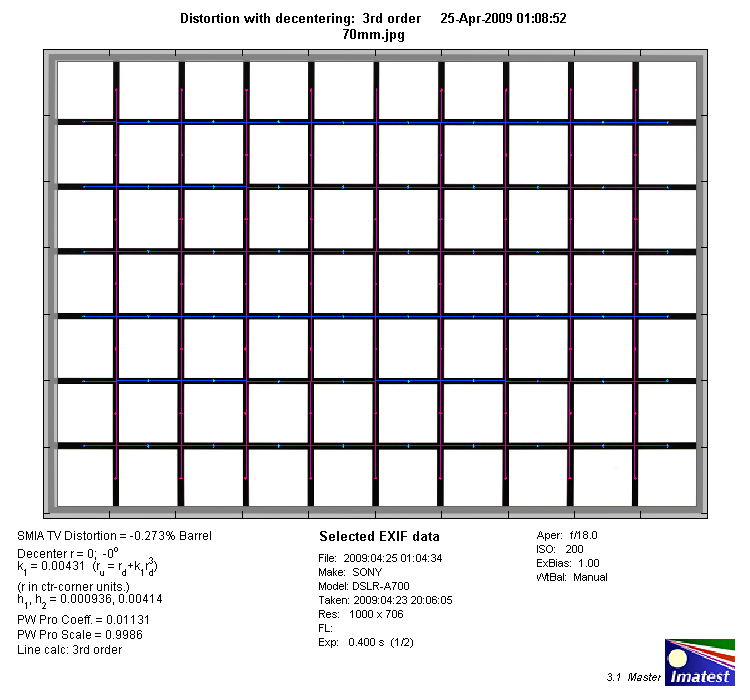|
Sony 70-400mm f/4-5.6 SSM G (SAL-70400G) - Review / Test Report - Analysis |
|
Lens Reviews -
Sony Alpha/NEX (APS-C)
|
|
Page 2 of 3

Distortion
The Sony 70-400mm G has no problems with respect to optical distortion whatsoever. There's only a very slight degree of barrel distortion at 70mm and very slight pincushion distortion at longer focal lengths. This is absolutely nothing to worry about in field conditions.
|
Move the mouse cursor over the focal length text marks below to observe the respective distortion
|
| 70mm |
200mm |
300mm |
400mm |

|
The chart above has a real-world size of about 120x80cm.
Vignetting
Thanks to the full format design the amount of vignetting (on APS-C DSLRs) is not field-relevant with a max. edge darkening of around 0.3EV at 70mm @ f/4 and 400mm @ f/5.6.

MTF (resolution)
The Sony 70-400mm G produced very good resolution figures in the MTF lab. The performance is best at 70mm with a generally excellent quality across the image field. There's a slight decrease in performance towards 200mm and a little more so at 300mm and 400mm respectively. Unsurprisingly the quality is "worst" at 400mm @ f/5.6 (also with slightly reduced contrast) but we're still talking about very good resolution figures here. Stopping down improves the border quality till reaching its maximum at f/8. The amount of field curvature is negligible.
Please note that the MTF results are not directly comparable across the different systems!
Below is a simplified summary of the formal findings. The chart shows line widths per picture height (LW/PH) which can be taken as a measure for sharpness.
If you want to know more about the MTF50 figures you may check out the corresponding Imatest Explanations
Chromatic Aberrations (CAs)
Lateral chromatic aberrations (color shadows at harsh contrast transitions) are generally well controlled especially in the mid to lower section of the zoom range. The problem is a bit more obvious at 400mm with an average CA width of around 1px at the image borders which is still very moderate in absolute terms.

Needless to say but you can correct or at least reduce lateral CAs during post-processing e.g. via Photoshop.
Bokeh (out-of-focus blur)
So far things looked very positive indeed. However, the lens has one glitch - the bokeh. To be precise the bokeh at the long of the zoom range (> 250mm). We didn't test this issue formally but it became quite apparent during our field tests. Here're two examples (100% crops) at 400mm @ f/5.6:

 I reckon that some of you may be a little shocked by this but to be honest this is not unusual. The Canon EF 100-400mm f/4.5-5.6 USM L IS and the Sigma AF 50-500mm f/4-6.3 EX HSM suffer from similar issues although maybe not this extreme (the highlights). The quality of the bokeh is still a weak spot of long tele zoom lenses compared to primes. As already hinted above the situation is also somewhat better at shorter focal lengths.
I reckon that some of you may be a little shocked by this but to be honest this is not unusual. The Canon EF 100-400mm f/4.5-5.6 USM L IS and the Sigma AF 50-500mm f/4-6.3 EX HSM suffer from similar issues although maybe not this extreme (the highlights). The quality of the bokeh is still a weak spot of long tele zoom lenses compared to primes. As already hinted above the situation is also somewhat better at shorter focal lengths.
|